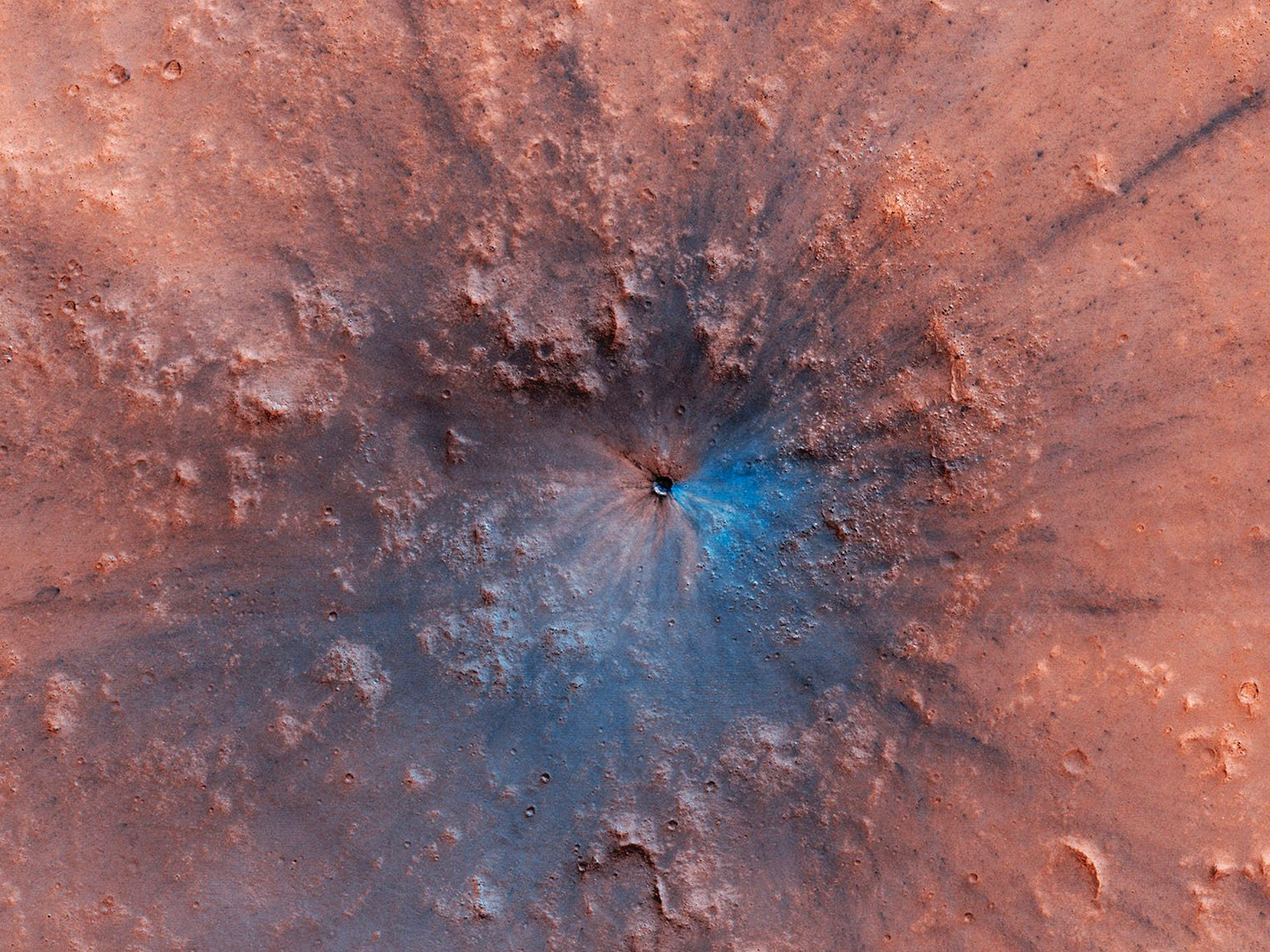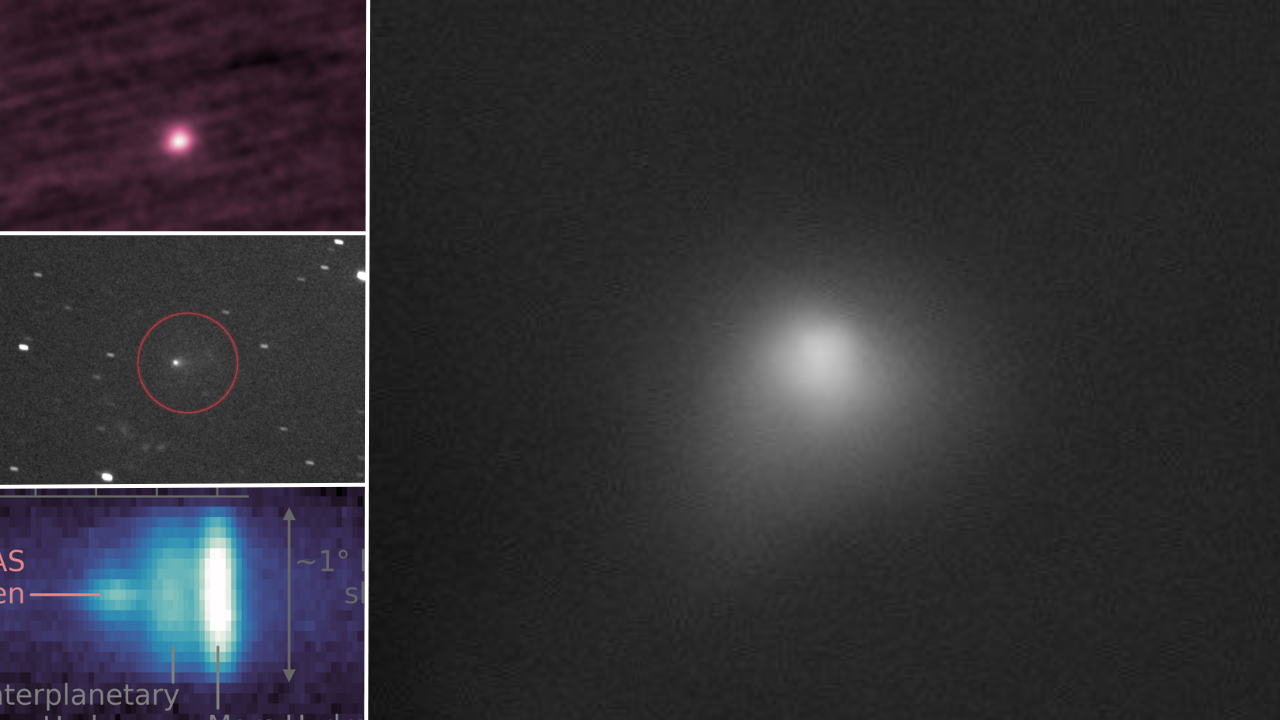Bam! Fresh Crater Spied on Mars — and It Looks Spectacular
Mars got whacked.
A small space rock crashed into the Red Planet's surface recently, producing a fresh crater that researchers estimate is 49 feet to 53 feet (15 to 16 meters) wide.
The dramatic feature is clearly visible in a newly released image from NASA's Mars Reconnaissance Orbiter (MRO). The spacecraft has been imaging the Red Planet up close for more than 13 years using its High Resolution Imaging Science Experiment (HiRISE) camera and photographing larger swaths of terrain with its lower-resolution Context Camera (CTX).
Related: Latest Photos from NASA's Mars Reconnaissance Orbiter
A color image from HiRISE, posted June 6 and taken in April, shows a large black-and-blue bruise on the landscape amid an otherwise flat area of red Martian dirt.
Because MRO cannot look everywhere at once, it's unclear exactly when the new crater formed; the best estimate is somewhere between September 2016 and February 2019, scientists said.
While MRO captures hundreds of these new dark smudges a year, said HiRISE team member and University of Arizona staff scientist Veronica Bray, this new crater is on the larger side of the ones that she has ever seen. That means the impact that created it was a fairly rare event, at least as far as we know from 13 years of MRO's continuous observing.
Breaking space news, the latest updates on rocket launches, skywatching events and more!
Bray estimated that the impactor responsible was about 5 feet (1.5 m) wide — so small that it would either have burst into pieces or eroded away completely had it come through Earth's much thicker atmosphere. The impactor might have been a more solid rock than usual, she added, because other rocks coming into Mars' atmosphere often shatter high in the air and create chains of craters as broken-up pieces smack into the terrain below.
"It is a reminder of what's out there," Bray, a HiRISE targeting specialist who imaged this new crater, told Space.com. She said that Mars is a dynamic place, complete with shifting sand dunes and whirling dust devils, but she finds craters the most interesting Red Planet surface features.
"It's a gorgeous [crater]. I'm glad I got it in the color strip," she said.
KABOOM! Before and after images of a meteorite forming a brand new impact crater on Mars. Sometime between 18 Feb 2017 and 20 March 2019. pic.twitter.com/TWXtUoP5NAJune 12, 2019
Bray added that the color of this particular crater fascinates her, because she can see the impact wave clearly — a dark zone where dust was shifted off the surface. Beneath is likely basaltic rock, based on what we know of Mars geology and the colors showing in the image. There also are zones with a bluish tint, which may or may not be exposed ice. While the crater was blasted in the Valles Marineris region, near the relatively warm Martian equator, it's possible there could be a little ice underneath the dust, Bray said.
She noted, however, that no recent spectroscopy of the area is available (as far as she knows) through another MRO instrument called CRISM (Compact Reconnaissance Imaging Spectrometer for Mars).
Even if CRISM does image the area, there will be some barriers to learning more about what minerals are in the region, Bray said. The 13-year-old instrument, which is operating well past its design lifetime, ran out of coolant long ago and has poorer resolution than when it first began. In a best-case scenario, the crater might take up one pixel of the CRISM image. (CRISM has a resolution of about 52 feet, or 16 m, per pixel, while that of HiRISE is 0.8 feet, or 25 centimeters, per pixel.)
'This kind of blew me away'
Mars researcher Peter Grindrod, an ExoMars program researcher and planetary scientist at London's Natural History Museum, posted a GIF on Twitter Wednesday (June 12) showing lower-resolution "before" and "after" photos from CTX, as well as a height map showing the crater in relation to the flat terrain around it. (He generated the height map by running HiRISE photos through a commercial software program.)
Grindrod said he regularly posts Mars photos on his feed just out of interest, often when he is about to give a public or scientific talk on the Red Planet. In this case, the crater really got his attention:
"This kind of blew me away," he told Space.com, referring to the size of the fresh crater. "I'd never seen anything like that."
Related: 7 Biggest Mysteries of Mars
He added that this work is only possible because HiRISE provides so much of its data openly, allowing for re-publication and modification of the imagery for scientists or interested members of the public who want to learn more about Mars.
"Everything we do is open data, and we give away as many of these as we can," he said about space researchers, adding that participating mission scientists often have a brief period with exclusive access to the data so they can publish their own discoveries first.
While Grindrod is not a member of the HiRISE team, he regularly contributes to the Digital Terrain Model archive on the HiRISE website because he enjoys generating height maps, he said. These show Martian features in the context of the surrounding terrain, helping to give geological context to features such as dust devils or craters.
Preparing for more Mars work
Spacecraft continue to join the venerable MRO at and around the Red Planet. Grindrod has several affiliations with ExoMars, the two-phase British-Russian robotic exploration program.
For example, he's is a guest investigator with ExoMars' Trace Gas Orbiter, which arrived at the Red Planet in 2016. Grindrod is studying "active processes" such as dust devils and dunes. Before-and-after pictures are great for investigating these temporary phenomena, he explained, which is why he was inspired to make the GIF for the new crater.
TGO is the core of ExoMars' first phase. The second phase centers on a rover named Rosalind Franklin, which is scheduled to launch in July 2020 and land in February 2021. Grindrod's team generated height maps for dozens of proposed ExoMars rover landing sites as scientists debated where to go. He then provided these maps to the HiRISE group to post on their website.
"We gave them away to everyone who wanted them," he said. These height maps helped show researchers potential sites for water, an important item for looking for habitable environments, he explained.
Additionally, Grindrod participated in several ExoMars rover field trials between 2018 and 2019. A test rover was put through its paces in Utah, Spain and the Atacama Desert in Chile during three separate trials, with each attempt getting more complex and closer to what the real deal will be like on Mars.
Grindrod is also a member of Rosalind Franklin's panoramic camera team, which will provide geological context as the rover hunts for signs of previous life on the Red Planet. Since life as we know it requires liquid water, researchers on the search for habitable environments generally tend to look for formations (like clay) or minerals (like hematite) that usually form in the presence of water.
- NASA's Prolific Mars Orbiter Completes 60,000th Lap of Red Planet
- Mars Myths & Misconceptions: Quiz
- Icy Mars Crater Shines in European Probe's 1st Photo from New Orbit
Follow Elizabeth Howell on Twitter @howellspace. Follow us on Twitter @Spacedotcom and on Facebook.

Elizabeth Howell (she/her), Ph.D., was a staff writer in the spaceflight channel between 2022 and 2024 specializing in Canadian space news. She was contributing writer for Space.com for 10 years from 2012 to 2024. Elizabeth's reporting includes multiple exclusives with the White House, leading world coverage about a lost-and-found space tomato on the International Space Station, witnessing five human spaceflight launches on two continents, flying parabolic, working inside a spacesuit, and participating in a simulated Mars mission. Her latest book, "Why Am I Taller?" (ECW Press, 2022) is co-written with astronaut Dave Williams.

